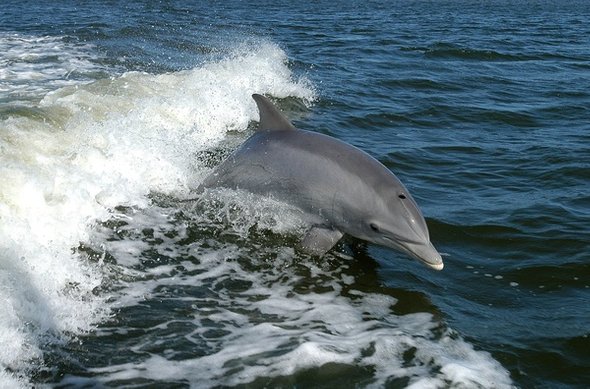Hurricanes: Bad for People, Good for Dolphins

Biologist Lance Miller noticed something odd while conducting dolphin surveys in the Gulf of Mexico in 2007: baby dolphins. Lots of them, and lots more than he expected given the results of surveys in 2005 and 2006. The reason? Hurricane Katrina.
Hurricanes like Harvey, the one that devastated Houston and other parts of Texas last week, and like Irma, the one currently threatening Florida, are typically associated with loss of life, loss of property, and other economic losses, the effects of which can be felt for years. That’s not only true for humans. It’s true for wildlife too.
Starting in December 2004—before Katrina struck—and continuing through November 2007, a group of scientists from the University of Southern Mississippi led by Miller (now at the Chicago Zoological Society), motored around the Gulf of Mexico looking for Atlantic bottlenose dolphins (Tursiops truncatus), initially as part of an study about their social organization.
But around two years after the storm passed, they noticed a massive increase in the number of dolphin calves in their study area. Hurricanes and other major storms are usually associated with increased strandings of marine mammals. So why would Katrina have been associated with more dolphins, not fewer?
Miller came up with two possible explanations. One, more baby dolphins were being born. Two, the same number of dolphins were being born each year, but more of them had survived past infancy.
Both were probably true. Here’s why.
In normal circumstances, female dolphins nurse their offspring for three or four years, which means that dolphin siblings are usually born at least five years apart. But Miller explained, writing in the journal Marine Mammal Science in 2010, that after a female bottlenose dolphin loses a calf, she is ready to give birth again the following season.
If Katrina had wiped out many of the baby dolphins born earlier that year, then each of those mothers would have been able to become reproductively active again the following year. That would have explained at least part of the spike in dolphin births.
Indeed, stranding data did show a slight increase in juvenile dolphin mortality after Katrina. And when the researchers surveyed the population in the fall of 2005, after the storm had passed, they found proportionally more adults than juveniles, suggesting that the adults had been more likely to survive.
But these trends alone wouldn’t have been enough to entirely explain the baby boom that Miller’s team observed. To explain the rest he had to look towards human activities.
Massive hurricanes don’t just destroy homes and businesses; they also damage fishing vessels. According to one estimate, Katrina wiped out 87 percent of all the commercial fishing, crabbing, and shrimping vessels in Mississippi. In 2005 and 2006, fishing vessels in that state hauled in nearly one million fewer pounds of seafood.
That means that there were fewer boats in the water and also that there was more food for the dolphins. Commercial fisheries target three quarters of the species that make up the Mississippi dolphins’ diets, and two thirds are fished for sport. More food makes pregnant females more likely to deliver healthy babies, and it also makes them better able to nourish their offspring through their milk.
It’s too early to say how Harvey and Irma will impact marine wildlife communities. But Katrina teaches us that by being forced to reduce our fishing activities, we inadvertently created an environment that allowed young dolphins to flourish. The fisheries disruption following that storm was so significant that it was as if a marine reserve had been created in its path.
source: https://blogs.scientificamerican.com/observations/hurricanes-bad-for-people-good-for-dolphins/

